UOGML Dive Manual - University of Guam Marine Laboratory
UOGML Dive Manual - University of Guam Marine Laboratory
UOGML Dive Manual - University of Guam Marine Laboratory
You also want an ePaper? Increase the reach of your titles
YUMPU automatically turns print PDFs into web optimized ePapers that Google loves.
analysis; personnel requirements; equipment marking and maintenance<br />
requirements; dive station requirements.<br />
b) DCB may choose to limit standard nitrox diver training to procedures applicable<br />
to diving, and subsequently reserve training such as nitrox production methods,<br />
oxygen cleaning, and dive station topics to divers requiring specialized<br />
authorization in these areas.<br />
8.3.2 Practical Training<br />
The practical training portion will consist <strong>of</strong> a review <strong>of</strong> skills as stated for scuba<br />
(Section 4.00), with additional training as follows:<br />
a) Oxygen analysis <strong>of</strong> nitrox mixtures.<br />
b) Determination <strong>of</strong> MOD, oxygen partial pressure exposure, and oxygen toxicity<br />
time limits, for various nitrox mixtures at various depths.<br />
c) Determination <strong>of</strong> nitrogen-based dive limits status by EAD method using air<br />
dive tables, and/or using nitrox dive tables, as approved by the DCB.<br />
d) Nitrox dive computer use may be included, as approved by the DCB.<br />
8.3.3 Written Examination (based on classroom instruction and practical training)<br />
Before authorization, the trainee should successfully pass a written examination<br />
demonstrating knowledge <strong>of</strong> at least the following:<br />
a) Function, care, use, and maintenance <strong>of</strong> equipment cleaned for nitrox use.<br />
b) Physical and physiological considerations <strong>of</strong> nitrox diving (ex.: O2 and CO 2<br />
toxicity).<br />
c) Diving regulations and procedures as related to nitrox diving, either scuba or<br />
surface-supplied (depending on intended mode).<br />
d) Given the proper information, calculation <strong>of</strong>:<br />
1. Equivalent air depth (EAD) for a given f0 2 and actual depth;<br />
2. p02 exposure for a given f02 and depth;<br />
3. Optimal nitrox mixture for a given p02 exposure limit and planned depth;<br />
4. Maximum operational depth (MOD) for a given mix and p02 exposure<br />
limit;<br />
23
















